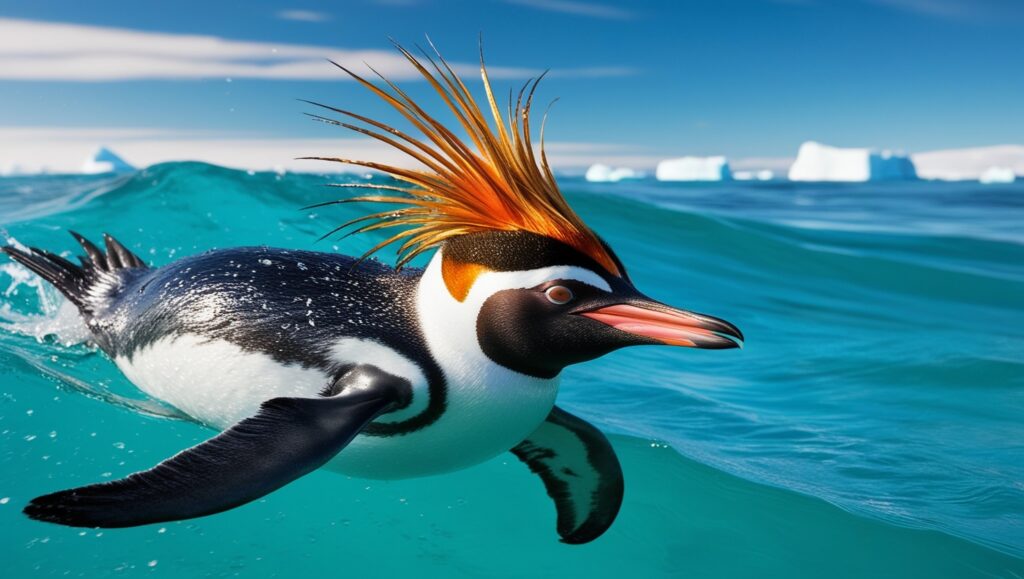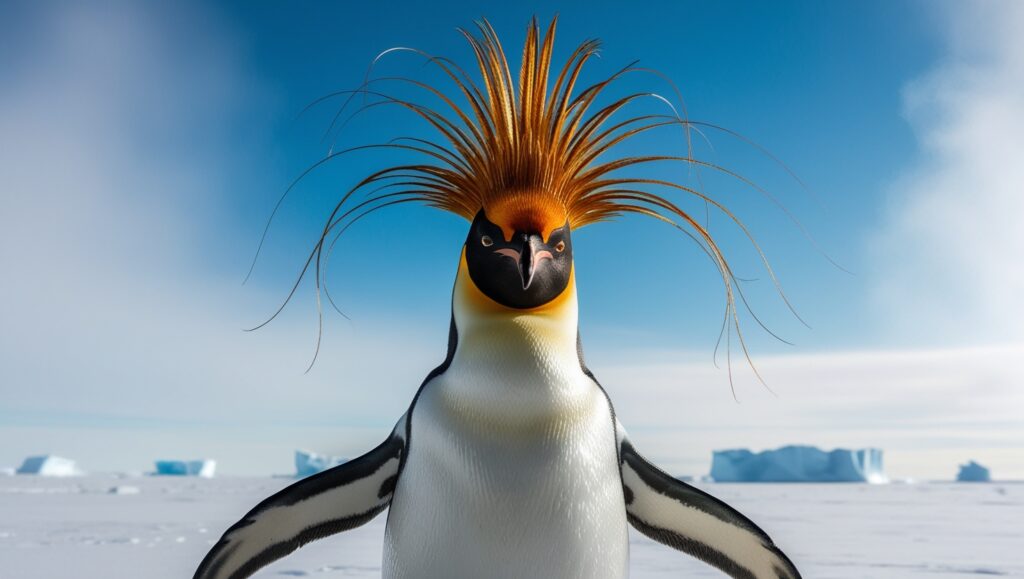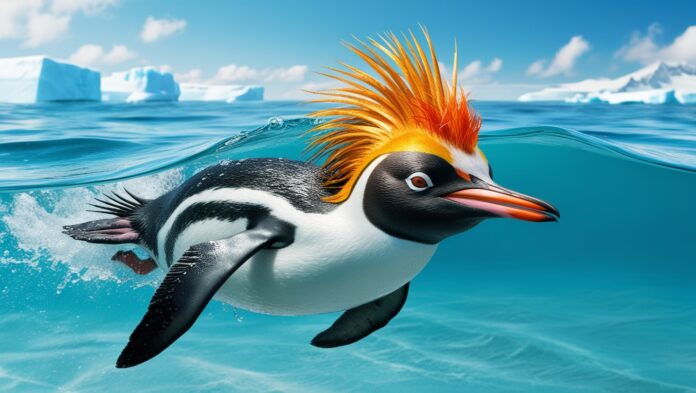
the Macaroni Penguin Is a Fascinating Bird with Its Striking Appearance and Interesting Behavior That Has Attracted the Attention of Nature Lovers and Scientists. This Medium-Sized Penguin, Known for Its Vibrant Yellow Crest and Distinctive Black and White Plumage, Is One of Numerous Penguin Species. in This Article, We’ll Explore the World of the Macaroni Penguin, Examining Its Habitat, Diet, Breeding Habits, and the Challenges It Faces in the Wild. This Comprehensive Look Will Give You a Deeper Understanding of This Remarkable Creature, Presented in Clear and Easy-To-Understand Language.
What Is a Macaroni Penguin?
the Macaroni Penguin (Eudyptes Chrysolophus) Is a Member of the Crested Penguin Family. It Is About 28 Inches Long and Weighs Between 11 and 13 Pounds. His Name Comes from the Yellow-Orange Crest That Runs Across the Top of His Head, Resembling the Flamboyant Fashion of 18th-Century “Macarons”, a Term Used to Describe Men Who Wear Elaborate and Fashionable Clothes. This Crest, Combined with Its Bright Red Eyes and Sharp Black Beak, Makes the Macaroni Penguin One of the Most Visible Birds in the Penguin Family.
Where Do Macaroni Penguins Live?
Macaroni penguins live in the sub-Antarctic and Antarctic regions. They Breed on Rocky, Ice-Free Islands, with Large Colonies on the South Sandwich Islands, South Georgia, and Crozet Islands. These Areas Are Ideal for Nesting and Raising Their Young, Providing Plenty of Space and Access to the Sea for Food.
During the Breeding Season, These Penguins Return to the Colonies Where They Were Born. Outside of Breeding, They Spend Most of Their Time at Sea, Traveling Long Distances in Search of Food. They Are Strong Swimmers, Capable of Diving as Deep as 230 Feet, Although Most of Their Forage Is at Shallower Depths.
Diet and Feeding Habits
Macaroni Penguins Are Carnivores, Their Diet Consists Mainly of Krill, Small Fish and Squid. Krill Are the Most Important Part of Their Diet, Especially During the Breeding Season When Energy Demands Are High. They Feed by Diving Underwater, Using Their Fins to Propel Themselves Through the Water and Catch Prey with Their Sharp Beaks.
These Penguins Are Known to Be Skilled Hunters, Often Diving 100 Times a Day in Search of Food. Their Ability to Store Fat Allows Them to Go Without Food for Long Periods of Time, Which Is Especially Useful During the Breeding Season When One Parent Stays Behind to Guard the Eggs or Chicks While the Other Forages. Goes Out.
Breeding and Life Cycle
Macaroni Penguins’ Breeding Season Begins in October When They Return to Their Colonies. These Colonies Can Consist of Thousands of Birds, Nesting Together All Over the Rocky Slopes. Males Arrive First to Establish Nesting Sites, and Females Soon Follow.
Macaroni Penguins Are Monogamous, Meaning They Have One Mate for Life. Once the Pair Is Reunited, They Engage in Several Displays to Strengthen Their Bond, Including Head Bobbing and Vocal Calls. the Female Usually Lays Two Eggs, but Usually Only One Chick Survives, as the First Egg Is Often Small and Less Likely to Hatch.
After the Eggs Are Laid, the Parents Incubate Them for About 33 to 37 Days. During This Period, the Non-Egg-Laying Parents Go Out to Sea to Feed. After the Chicks Hatch, They Are Cared for by Both Parents, One Guarding the Chick While the Other Forages. This Continues Until the Chicks Are Old Enough to Join a Crèche, a Group of Young Penguins That Gather Together for Warmth and Protection.

Challenges and Threats
Despite Being One of the Most Numerous Penguin Species, Macaroni Penguins Face Many Challenges in the Wild. Climate Change Is a Major Threat, as It Affects the Availability of Krill, Their Primary Food Source. Warming Ocean Temperatures and Melting Sea Ice Reduce Krill Populations, Making It Difficult for Macaroni Penguins to Find Enough Food to Sustain Themselves and Their Young.
Overfishing Is Another Concern, as It Competes with Macaroni Penguins for the Same Food Sources. in Some Regions, Commercial Fishing Has Led to Declines in Fish and Squid Populations, Putting Further Pressure on the Food Supply for These Penguins.
Human Activities, Including Pollution and Habitat Disturbance, Also Pose Risks. Oil Spills Can Be Particularly Devastating, as They Can Coat Penguins’ Wings, Reducing Their Ability to Insulate Themselves and Making It Difficult to Swim. Additionally, the Introduction of Non-Native Predators, Such as Rats and Cats, to Breeding Islands Can Threaten Eggs and Chicks.
Conservation Efforts
Conservation Efforts Are Crucial to Ensuring the Survival of Macaroni Penguins. Many of Their Breeding Sites Are Located in Protected Areas, Reducing the Impact of Human Disturbance. International Agreements, Such as the Convention for the Conservation of Antarctic Marine Living Resources (Ccamlr), Regulate Fishing in the Southern Ocean to Prevent Overfishing and Ensure That Enough Food Remains for Penguin Populations.
Researchers Also Monitor Macaroni Penguin Populations Closely, Tracking Their Movements and Breeding Success to Gather Data That Can Inform Conservation Strategies. Public Awareness and Education Campaigns Are Vital in Raising Awareness About the Challenges These Penguins Face and Encouraging Responsible Behavior in Areas Where They Live.
Fascinating Facts About Macaroni Penguins
- Swimming Powerhouses: Macaroni Penguins Can Travel Up to 6,000 Miles a Year in Search of Food, Showcasing Their Incredible Endurance and Swimming Abilities.
- Vocal Communicators: These Penguins Use a Variety of Vocal Calls to Communicate, Especially During the Breeding Season. Each Call Is Unique, Helping Mates and Chicks Recognize Each Other in Large Colonies.
- Molting Season: After the Breeding Season, Macaroni Penguins Undergo a Molting Process, Where They Shed Their Old Feathers and Grow New Ones. During This Time, They Stay on Land as Their New Feathers Grow, Making Them Waterproof Again.
- Large Colonies: Macaroni Penguin Colonies Can Consist of Hundreds of Thousands of Birds, Making Them One of the Largest Penguin Colonies in the World.
Conclusion
the Macaroni Penguin Is a Fascinating and Resilient Bird, Perfectly Suited to the Harsh Conditions of the Antarctic and Sub-Antarctic Regions. Despite Facing a Number of Challenges, from Climate Change to Human Activity, These Penguins Continue to Thrive in Large Numbers, Thanks in Part to Ongoing Conservation Efforts. by Learning More About These Unique Creatures, We Can Better Understand the Importance of Protecting Their Habitats and Ensuring Their Survival for Future Generations.

- What Makes the Macaroni Penguin Unique?
- the Macaroni Penguin Is Known for Its Distinctive Yellow-Orange Crest Feathers on Its Head, Which Resemble the Elaborate Hairstyles of 18th-Century “Macaronis.” This Feature, Along with Their Red Eyes and Sharp Black Beak, Makes Them Stand Out Among Other Penguin Species.
- Where Can Macaroni Penguins Be Found?
- Macaroni Penguins Are Primarily Found in the Sub-Antarctic and Antarctic Regions. They Breed on Rocky, Ice-Free Islands Such as the South Sandwich Islands, South Georgia, and the Crozet Islands, and Spend Much of Their Time at Sea Outside the Breeding Season.
- What Do Macaroni Penguins Eat?
- Macaroni penguins primarily eat krill, small fish, and squid.. Krill Is the Most Important Part of Their Diet, Especially During the Breeding Season When They Need Extra Energy.
- How Do Macaroni Penguins Care for Their Young?
- Macaroni Penguins Are Monogamous and Both Parents Take Turns Incubating the Eggs and Feeding the Chick. After Hatching, the Chick Is Cared for by Both Parents Until It Is Old Enough to Join a Crèche, Where It Huddles with Other Young Penguins for Warmth and Protection.
- What Are the Biggest Threats to Macaroni Penguins?
- the Biggest Threats to Macaroni Penguins Include Climate Change, Which Affects Their Food Supply, Overfishing, Which Competes for Their Food Sources, and Human Activities Such as Pollution and Habitat Disturbance. Conservation Efforts Are in Place to Protect Them from These Threats.

